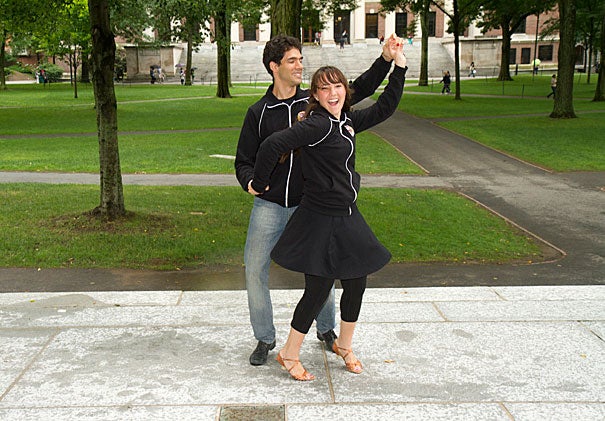
Harvard Ballroom dance instructors Drago Guggiana-Nilo and Cristina Foyo Cardenas perform some dance moves from their beginning salsa class on the steps of Memorial Church. “Dancing has helped me to be more confident,” said Foyo Cardenas.
Jon Chase/Harvard Staff Photographer
Sneakers, flip-flops, stilettos
Harvard Ballroom attracts aspiring dancers from all walks of life
Inside Holden Chapel, dozens of salsa beginners face one another, feet shifting slightly on the hardwood, waiting. Then Drago Guggiana-Nilo calls out “five, six, seven, eight,” and the class bursts into action, sashaying toward embrace.
The event was just one of the many classes offered by Harvard Ballroom, a nonprofit, student-run dance organization that offers social dance classes throughout the year. This summer, dance students learned how to swing, tango, salsa, and waltz, culminating in an open social dance event at the end of the session.
A graduate student in biophysics, Guggiana-Nilo joined the Harvard Ballroom team in 2011. “I went to one of the social dances, saw a couple of performances, and I immediately knew: I wanted to do this.” He has taught beginning salsa for Harvard Ballroom for two years running.
The other instructor for the class, Cristina Foyo Cardenas, is completing an English as a second language (ESL) program at the Extension School. Like Guggiana-Nilo, she learned about Harvard Ballroom through a social dance event.
“Dancing has helped me to be more confident,” she said. “Everyone is so welcoming, and you can meet people from all over the world in the same room.”
While women slightly outnumber men, instructors have devised a creative solution. Female dancers stand in an inner circle facing out, and are surrounded by an outer circle of male dancers, who rotate to a new partner every few minutes. As a result, no one goes without a dance partner for longer than a round. The approach also heightens the “social” aspect of dancing, with individuals meeting a new partner every few minutes.
One of the advantages for international students, Foyo Cardenas said, is that dancing is such a universal language. “You learn how to communicate through touch, to be sensitive, to pay closer attention,” she said. “And before you know it, you’re dancing.”
Salsa student Gil Alterovitz, assistant professor of pediatrics and research associate in biomedical informatics, said that in addition to introducing him to a diverse group of fellow dancers, the classes have influenced his research.
“It’s given me a new perspective,” he said. “In one project, my group has conveyed the language of gene expression as well as connectivity through use of music and 3-D modeling of movement — so it’s led to some interesting avenues.”
Violet Li ’14, president of Harvard Ballroom, has been dancing ever since she arrived on campus. She said that the decision to open social dance classes beyond Harvard affiliates and students helps create a stronger community of dancers.
“It replicates the social dance environment outside of Harvard, because we encourage our students to go to clubs and actually try the moves they’ve learned in class,” she said. “And because we open our classes to everyone, we learn how to be better teachers as well.”
For Foyo Cardenas, dancing is more than just good exercise and a dynamic way to meet new people.
“When you’re listening to music and dancing, everything else falls away,” Foyo Cardenas said. “When you see everyone else dancing with you, enjoying themselves … it’s a space where you can just feel good.”




